How people use ChatGPT and its implications, Portfolio Change
There was a lot of chatter about an NBER working paper “How People Use ChatGPT” yesterday. Unlike most survey work or academic paper looking into this question, what differentiates this paper is it is written by people at OpenAI. As you can imagine, there is a treasure trove of interesting and more importantly, high quality data here since there is lot less guess work.
So the paper provides analysis of the chatbot's consumer usage from its November 2022 launch through July 2025 based on actual usage data and pattern. By July 2025, ChatGPT reached 700 million weekly active users (~10% of the global adult population) who collectively sent 18 billion messages per week. This rapid diffusion continues, with total message volume growing 5x between July 2024 and July 2025, driven by both new users and increased engagement from existing cohorts.
A key revelation is the dominance of non-work-related usage. While work usage grew, non-work messages expanded much faster, increasing from 53% of total volume in June 2024 to 73% in June 2025. From the paper:
“Table 1 shows the growth in total message volume for work and non-work usage. Both types of messages have grown continuously, but non-work messages have grown faster and now represent more than 70% of all consumer ChatGPT messages. While most economic analysis of AI has focused on its impact on productivity in paid work, the impact on activity outside of work (home production) is on a similar scale and possibly larger. The decrease in the share of work-related messages is primarily due to changing usage within each cohort of users rather than a change in the composition of new ChatGPT users.”

I have heard before that for most people, chat bot usage is mostly one-way street i.e. you find more and more new ways to use chat bots in your work and personal lives. Indeed, that’s exactly what the data shows. Every cohort’s usage has only increased over time.
“The figure shows that earlier sign-ups have consistently had higher usage, but that usage has also consistently grown within every cohort, which we interpret as due to both (1) improvements in the capabilities of the models, and (2) users slowly discovering new uses for existing capabilities”
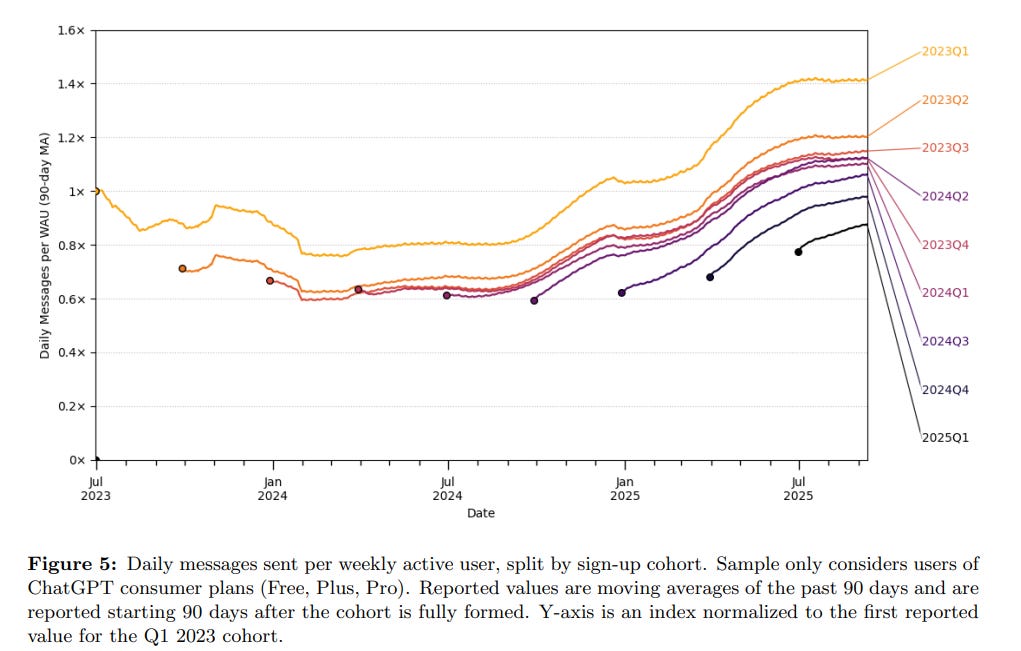
Okay, so people are using it more over time and non-work messages are increasingly being more and more dominant. Let’s now look into the types of queries people are asking ChatGPT.
Usage is highly concentrated in three main categories accounting for nearly 80% of all conversations: "Practical Guidance" (e.g., tutoring, advice, ideation), "Seeking Information" (e.g., factual search, current events), and "Writing" (e.g., drafting, editing, translation).
When used for work, Writing is the dominant application (40% of work-related messages), though two-thirds of these tasks involve modifying user-provided text rather than generating new content. The study classifies user intent as "Asking" (decision support) or "Doing" (task execution). While "Doing" makes up 56% of work usage, "Asking" is growing faster overall, constitutes 51.6% of total usage by June 2025.
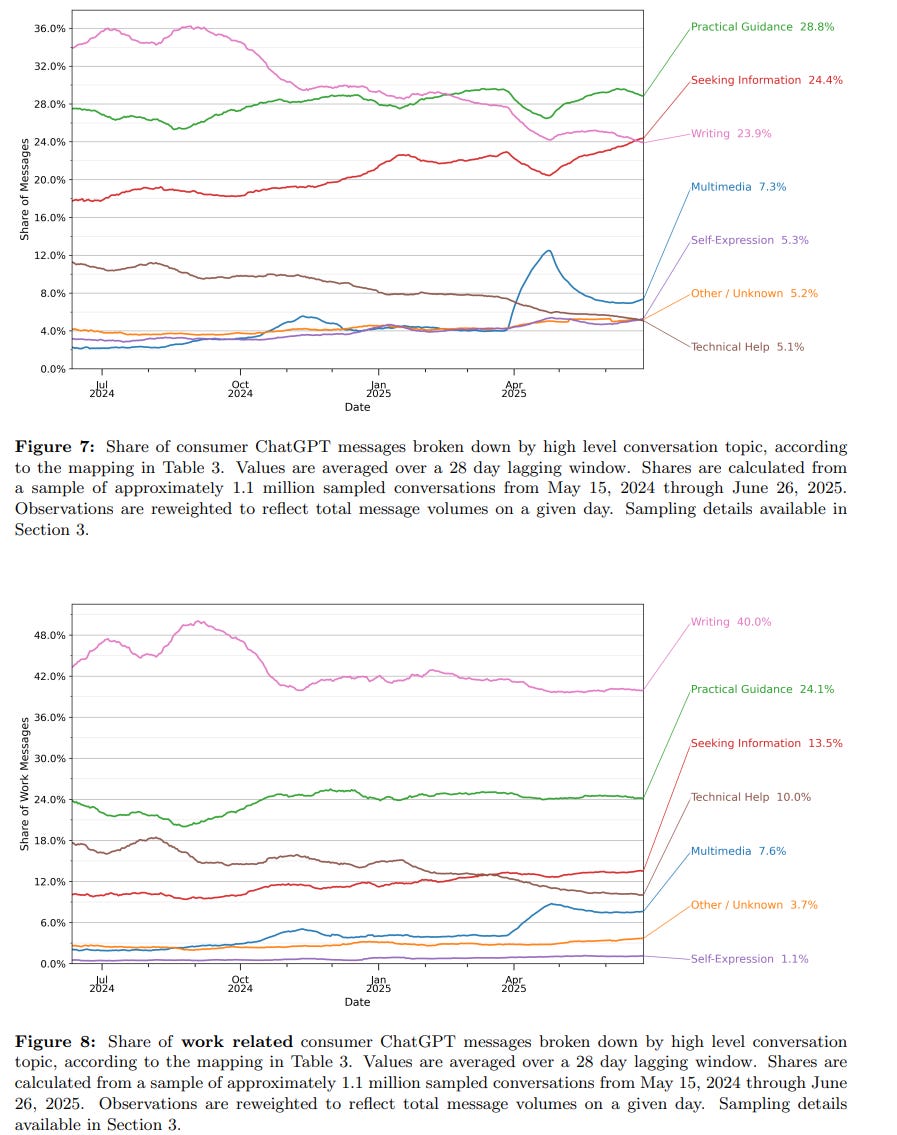
While considering both work and non-work related queries, there has been bit of an evolution of the query mix over time. From the paper:
Practical Guidance has remained constant at roughly 29% of overall usage. Writing has declined from 36% of all usage in July 2024 to 24% a year later. Seeking Information has grown from 14% to 24% of all usage over the same period.
As you may know, these data points can be Rorschach test for Google shareholders. On one hand, you can argue this paper makes it abundantly clear that chat bot usage expands the query TAM and “seeking information” is just a small sub-set of the TAM. That’s true, but it is also less assuring that query mix has gone from 14% to 24% in just one year for “Seeking information”. Perhaps the bear case for Google is not that ChatGPT is a Google replacement, rather ChatGPT makes Google increasingly irrelevant since the core “seeking information” function is just a small subset of what you can accomplish with ChatGPT.
As we all know, Google is responding. The reality is Google is hardly just a “query box”; it is also dozen other things that all feed to protect and grow the golden goose of search. So, even though they do make supermajority of their profits from the search query box, our interaction with search for a while has already been only a subset of all of Google’s properties (Chrome, YouTube, email, calendar, Google Drive, Photos etc.).
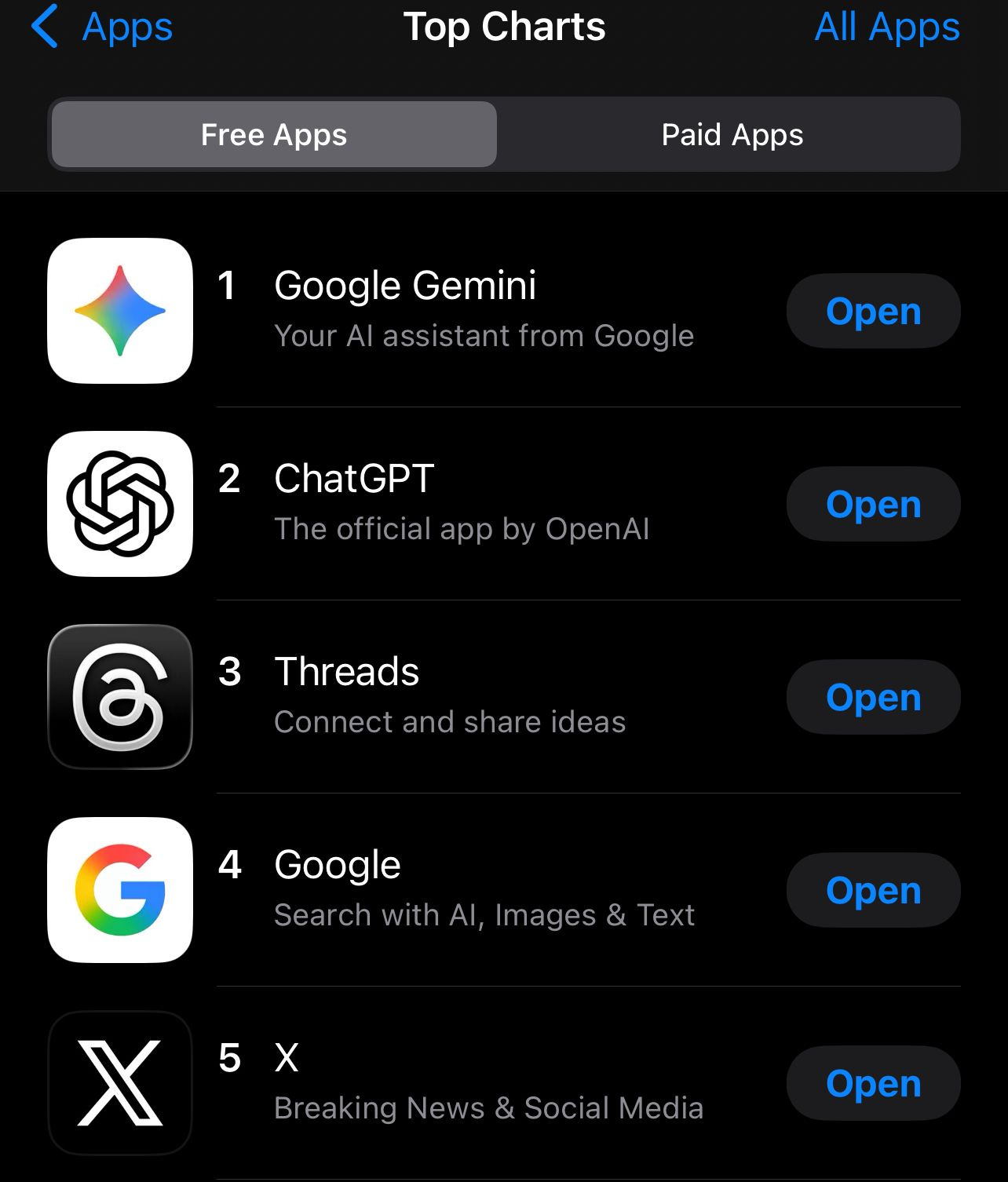
The other data point that will somewhat reassure Google shareholders is not only “seeking information” is just one-fifth of the overall queries, queries that can lead to “purchasable products” is only ~2%! Of course, Google's advertising revenue relies heavily on searches with commercial intent and it appears queries with such intent is rarer than most investors might have imagined. For context, ~15% of Google queries have commercial intent.
One interesting data point from the paper was computer programming accounts for only 4.2% of messages, and companionship or social-emotional topics account for just 1.9%. Imagine how much airtime people give to use cases such as “AI boyfriend or girlfriend” and it turns out most of us are not actually weirdos trying to date our ChatGPT. Of course, there is a shock value in pointing out such weird behaviors, but it’s good to remember these data as we may increasingly see some chatbot related hysteria going forward.
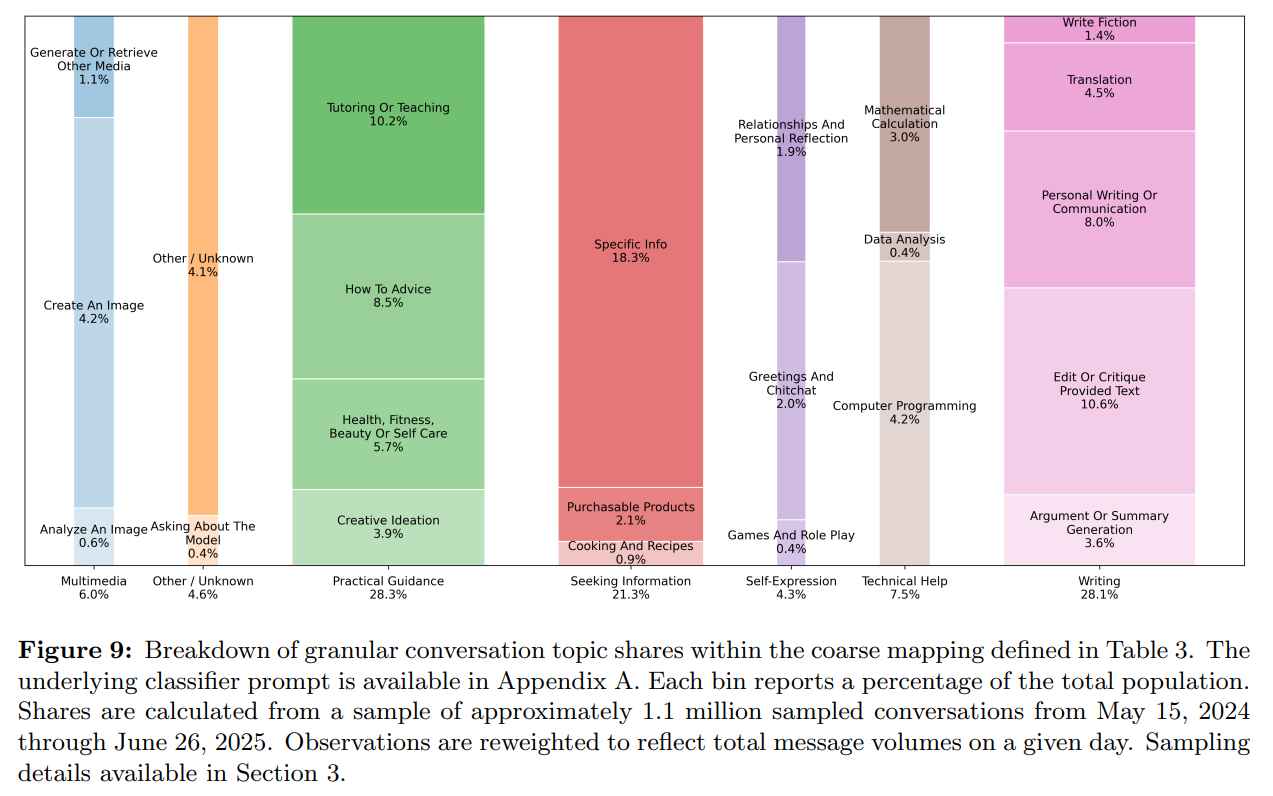
Demographically, the user base has evolved significantly. Early adoption was overwhelmingly male (80%), but this gap closed entirely by June 2025. The user base remains young, with nearly half of all messages sent by adults under 26. Geographically, growth rates over the past year have been disproportionately high in low and middle-income countries, signaling rapid diffusion in emerging markets. From the paper:
“Comparing May 2024 to May 2025, we see that the adoption of ChatGPT grew dramatically, but also that there was disproportionate growth in low to middle-income countries ($10,000–40,000 GDP-per-capita). Overall, we find that many low-to-middle income countries have experienced high growth in ChatGPT adoption.”
It’s incredible to see just how much this graph has shifted in just one year! It’s good to see such diffusion of technology in different parts of the world in such a short time.
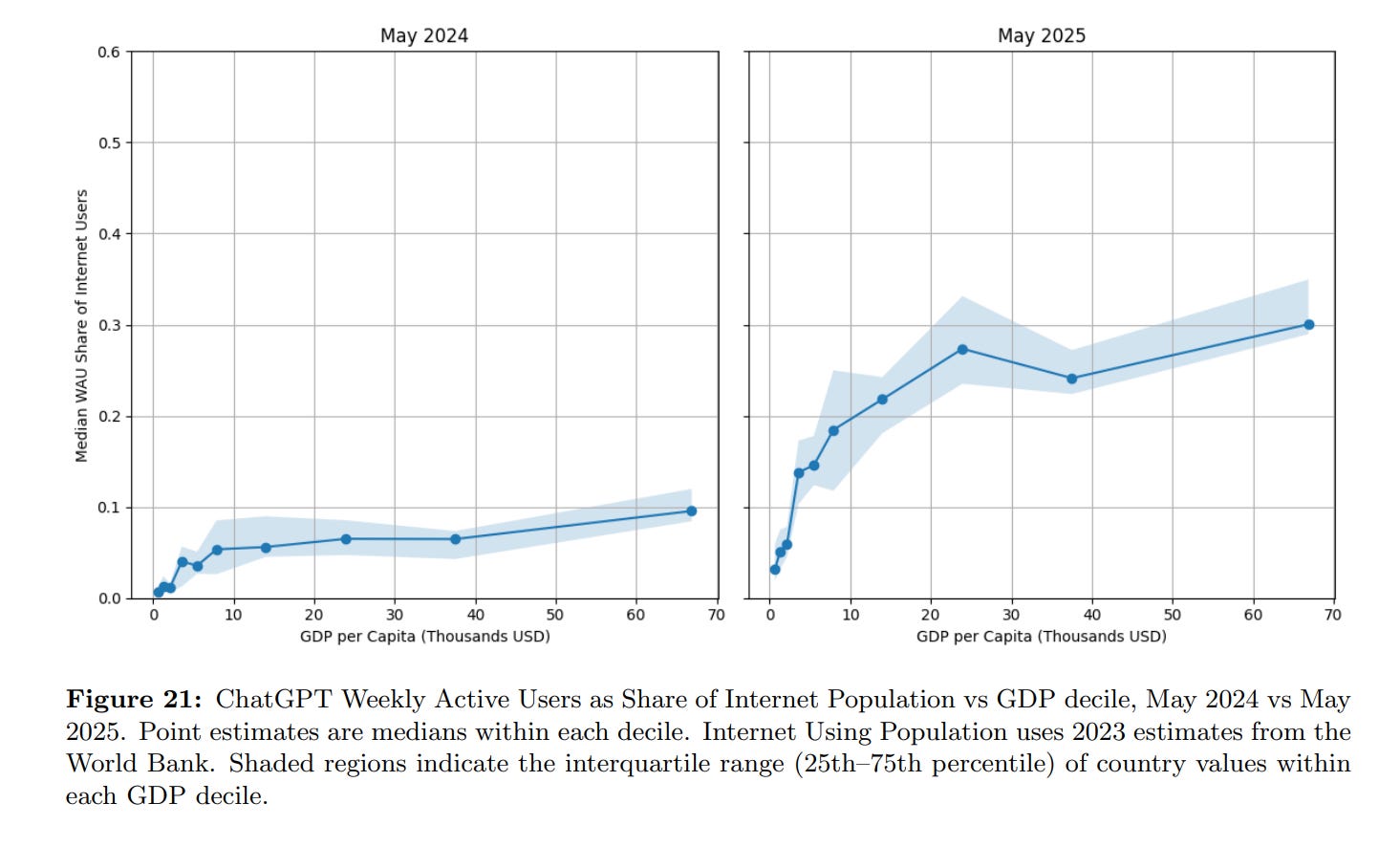
Overall, the paper helped me internalize something I already knew even more: ChatGPT’s canvas goes way beyond traditional search. Given the general purpose nature of SOTA models, the lines are inherently blurring when it comes to what exactly these chat bots are competing against.
In addition to "Daily Dose" (yes, DAILY) like this, MBI Deep Dives publishes one Deep Dive on a publicly listed company every month. You can find all the 62 Deep Dives here.
Current Portfolio:
Please note that these are NOT my recommendation to buy/sell these securities, but just disclosure from my end so that you can assess potential biases that I may have because of my own personal portfolio holdings. Always consider my write-up my personal investing journal and never forget my objectives, risk tolerance, and constraints may have no resemblance to yours.
I have made some changes to my portfolio which I will discuss behind the paywall.